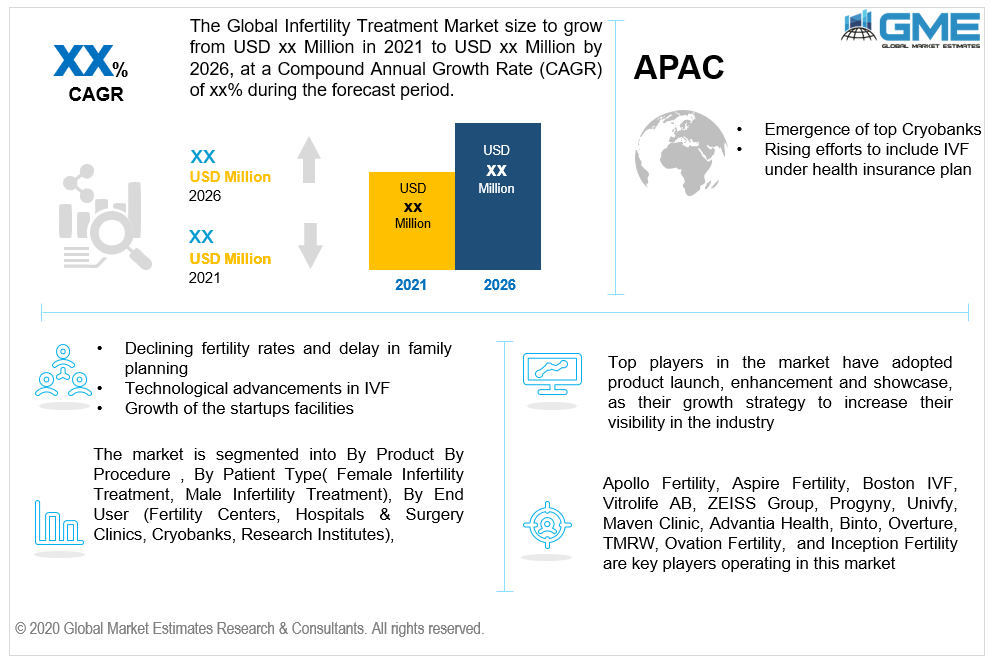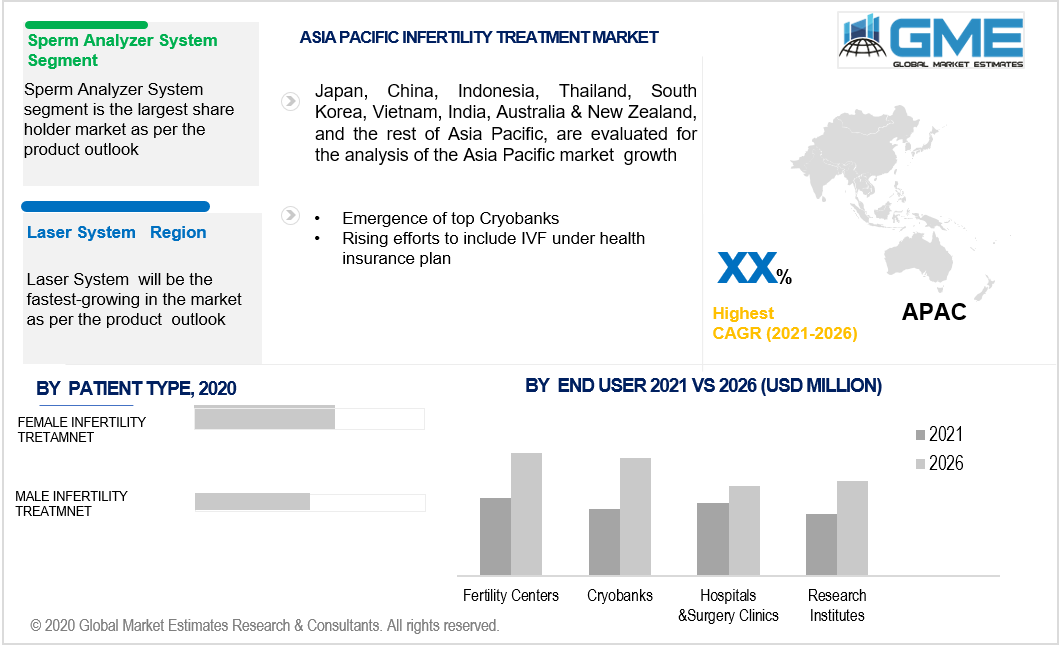
Global Infertility Treatment Market Size, Trends & Analysis - Forecasts to 2026 By Product (Equipment, Microscopes, Imaging Systems, Sperm Analyzer Systems, Ovum Aspiration Pumps, Micromanipulators Systems, Incubators, Gas Analyzers, Laser Systems, Cryosystems, Media & Consumables, Accessories), By Procedure (Assisted Reproductive Technology, In Vitro Fertilization, Intracytoplasmic Morphologically-Selected Sperm Injection (IMSI), Gamete Donation, Intracytoplasmic Sperm Injection (ICSI), Surrogacy, Intrauterine Insemination, Intracervical Insemination, Intratubal Insemination, Fertility Surgery, Laparoscopy, Hysteroscopy, Myomectomy, Laparotomy, Tubal Ligation, Reversal, Varicocelectomy, Microsurgical Reconstruction, Vasovasostomy), By Patient Type (Female Interfility Treatment, Male Infertility Treatment), By End User (Fertility Centers, Hospitals &Surgery Clinics, Cryobanks, Research Institutes), By Region (North America, Asia Pacific, Europe, Central & South America, Middle East & Africa); End-User Landscape, Company Market Share Analysis, and Competitor Analysis
Lifestyle changes trigger the advent of many chronic illnesses and diseases. The busy work schedule and lack of exercise result in the incidence of obesity and extreme stress condition. The effect of such incidence results in the plausible rise in infertility among females and males alike. Infertility cases have been on the rise owing to the increased BMI, intake of fewer nutrients, excessive smoking, and substance abuse. Another reason infertility is also rising is likely due to the delay in starting a family. It is estimated that around 45 per-cent of couples grapple with the issue of infertility. The rising infertility concerns pave the way for the treatment in place to treat infertility. Fertility drugs have been the most used and common type of infertility treatment recommended. Its presence in the market has been over for 40 years and is an ideal preferred choice among doctors. But the advanced technologies are taking over the market and families and doctors are shifting to IVF treatments. The introduction of the IVF apps is one technological change that is radically changing the treatment space. IVF apps are equipped to forecast the chances of succeeding and also provide ideal treatment options. The development of fertility technologies to improve the IVF success rate has long been approved and applied in this market. INVOcell, FDA-approved led to major changes in the traditional IVF method by drastically reducing the treatment costs.
The market paradigm is also including fertility apps to keep a track of the ovulation cycle and period cycle. With the apps, one can track the ovulation days, conceivable dates, and mood swings as well. Natural Cycles, Bellabeat, and Flo are some of the most used apps to track ovulation and period cycles. With the help of apps, women can make sound decisions and keep in check the stressors and hormones.
Policy initiatives also determine the long-term success of the market. The research and debates indicate the need to include infertility treatment under the insurance plan. IRDAI at present is planning to include infertility treatment( IVF) in the health insurance plan. Changes like this lead to less burdening on the couples and more advocation strategies for the treatment in the market.
Treatment costs and doctor visits can bear negatively on the individuals. But to better serve the market, scholarships and grants are available for couples seeking treatment. The USA market is widely supporting such grants for couples facing infertility issues.
This market space is growing with the growth of the startups in the fertility domain. The penetration of the startups in this fertility area is accrued to the large number of women seeking therapies and guidance on increasing the chances of fertility. Startups like Adia and Modern Fertility are focused on diagnostics a step further from the apps and trackers.
There is also increasing visibility of the wearable devices that help women to track the period and fertility cycle. Ava is one such wearable device. The advancement can also be tracked through the automation of the assisted technologies. IVF automation is slowly picking pace as Overture is enabling the automation possible in IVF and is also engaged in increasing the number of tools for automated cryopreservation. TMRW is another startup enabling the automation of fertility clinics.
The investors are potentially targeting heavy investment in clinics and fertility services as the declining fertility rates across the globe have created a large pool of infertility treatment and centers. Companies like Morgan Stanley are also pouring funds into treatment centers. Ovation Fertility in 2019 received investment from Morgan Stanely.
Partnerships and collaboration also lead to market expansion. In 2016 Prelude joined hands with Inception Fertility to increase the clinic’s strength in the USA.
Few other investors that have invested in the clinics are TA Associates and NextPhase Capital.

Sperm Analyzer System would observe a rising trend as the number of products introduced for the system is gaining momentum. Companies like Hamilton Throne are introducing advanced levels of systems and hardware platforms.
Laser systems would show promising growth as the tool leaves no toxic radiations on the living cells and has easy handling.
IVF as a procedure will show a dominant growth owing to the shift of the larger hospitals and consumers towards the use of IVF. The allocations of grants and necessary funds dedicated to the IVF treatment and launch of IVF apps by top players would ensure a high segment growth.
Surrogacy is gaining momentum in the west and is showing a rising trend in countries like India. The trending health tourism also has a positive working on the segment demand.
Treatment available for females would occupy a dominant space as social norms and assumptions perceive women to be highly infertile against their male counterparts. As a result, dedicated treatments and fertility drugs are receiving a lot of attention in this space.
Treatment for males is slowly picking pace due to rising awareness, the rising importance of surgeries to correct the dysfunction, and the presence of FDA-approved drugs to address male infertility.
Fertility centers would be rising upwards due to the rising importance of infertility treatment over the past years. Fertility clinics are better-equipped to deal with the issues of infertility. Discounts offered by the clinics and grants also work to better support the center’s growth.
Cryobanks’ importance in the market is sustained by the international players functioning in this domain. Cryoviva India is one such player providing high-quality services for this market.

North America’s persistent dominance is supported by the large-scale use of IVF, grants for IVF treatment in the USA, and rising infertility rates among USA women.
The Asia Pacific rising growth potential would be enhanced by the rising lifestyle changes, policy efforts to include IVF under the insurance plan, and the emergence of top cryobanks companies from the Indian market.
Apollo Fertility, Aspire Fertility, Boston IVF, Vitrolife AB, ZEISS Group, Progyny, Univfy, Maven Clinic, Advantia Health, Binto, Overture, TMRW, Ovation Fertility, and Inception Fertility are key players operating in this market.
Please note: This is not an exhaustive list of companies profiled in the report.
We value your investment and offer free customization with every report to fulfil your exact research needs.
The Global Infertility Treatment Market has been studied from the year 2019 till 2026. However, the CAGR provided in the report is from the year 2021 to 2026. The research methodology involved three stages: Desk research, Primary research, and Analysis & Output from the entire research process.

The desk research involved a robust background study which meant referring to paid and unpaid databases to understand the market dynamics; mapping contracts from press releases; identifying the key players in the market, studying their product portfolio, competition level, annual reports/SEC filings & investor presentations; and learning the demand and supply-side analysis for the Infertility Treatment Market.

The primary research activity included telephonic conversations with more than 50 tier 1 industry consultants, distributors, and end-use product manufacturers.

Finally, based on the above thorough research process, an in-depth analysis was carried out considering the following aspects: market attractiveness, current & future market trends, market share analysis, SWOT analysis of the company and customer analytics.

Tailor made solutions just for you
80% of our clients seek made-to-order reports. How do you want us to tailor yours?
OUR CLIENTS